Exercise 1: Computation of equivalent units under weighted average and FIFO method
Learning objective:
This exercise illustrates the computation of equivalent units of production under both the weighted average and the FIFO method.
Exercise 1 (a):
Mexico Company manufactures a single product that goes through two departments. The data relating to activity performed in the first department during the month of June is given below:
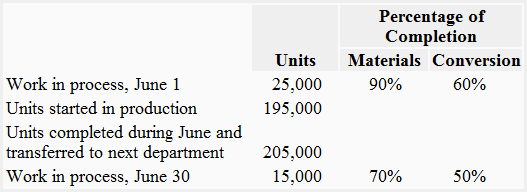
Required: Compute the equivalent units of production assuming the company uses:
- a weighted average method.
- a FIFO method.
Solution
1. Equivalent units of production under weighted average method:
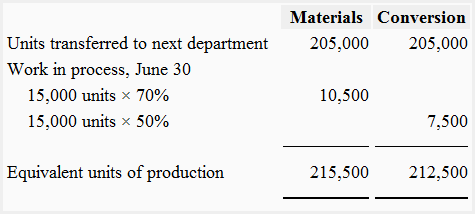
2. Equivalent units of production under FIFO method:
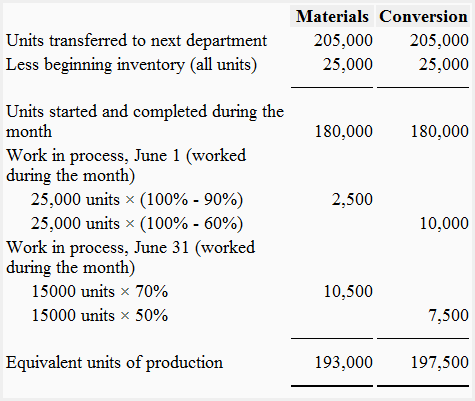
Exercise 1 (b):
The following data belongs to three different independent situations:
- Situation 1:
Started in process: 26,000 units
Transferred out: 22,000 units
Work in process ending inventory: 1,600 units 1/2 completed and 2,400 units 1/4 completed - Situation 2:
Work in process beginning inventory: 25,000 units, 2/5 completed
Started in process: 100,000 units
Transferred out: 105,000 units
Work in process ending inventory: 12,000 units 1/2 completed and 8,000 units 1/4 completed - Situation 3:
Work in process beginning inventory: 18,000 units 1/3 completed and 12,000 units 1/2 completed
Started in process: 75,000 units
Transferred out: 90,000 units
Work in process ending inventory: 6,000 units 1/2 completed and 9,000 units 1/3 completed
Units transferred out are 100% complete with respect to all cost elements. The stages of completion mentioned for beginning and ending inventories are applicable to all cost elements.
Required: Compute the equivalent production in each of the above situations using:
- the weighted average costing method.
- the FIFO costing method.
Solution
1. Equivalent production under weighted average method:
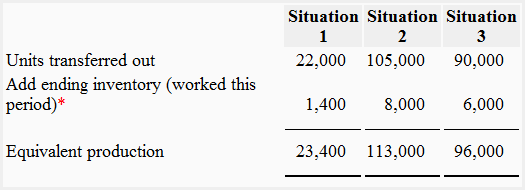
*Equivalent units in ending inventory:
The equivalent units in work-in-process ending inventory consist of the percentage of work done in the current period. The computations of equivalent units in work-in-process ending inventory for all three situations are given below:
Situation 1:
= (1600 units × 1/2) + (2400 units × 1/4)
= 800 units + 600 units
= 1,400 units
Situation 2:
= (12,000 units × 1/2) + (8,000 units × 1/4)
= 6,000 units + 2,000 units
= 8,000 units
Situation 3:
= (6,000 units × 1/2) + (9000 units × 1/3)
= 3,000 units + 3,000 units
= 6,000 units
2. Equivalent production under FIFO method
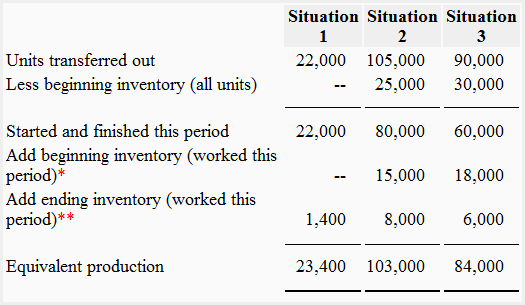
*Equivalent units in beginning inventory:
The equivalent units in work-in-process beginning inventory consist of the percentage of work done in the current period. The computations of equivalent units in work-in-process beginning inventory for all three situations are given below:
Situation 1:
There is no beginning inventory in situation 1.
Situation 2:
= 25,000 units × 3/5
= 15,000 units
Situation 3:
= (18,000 units × 2/3) + (12,000 units × 1/2)
= 12,000 units + 6,000 units
= 18,000 units
**Equivalent units in ending inventory:
The equivalent units in work-in-process ending inventory consist of the percentage of work done in the current period. The computations of equivalent units in work-in-process ending inventory for the FIFO method are the same as under the weighted average method.
Situation 1:
= (1600 units × 1/2) + (2400 units × 1/4)
= 800 units + 600 units
= 1,400 units
Situation 2:
= (12,000 units × 1/2) + (8,000 units × 1/4)
= 6,000 units + 2,000 units
= 8,000 units
Situation 3:
= (6,000 units × 1/2) + (9000 units × 1/3)
= 3,000 units + 3,000 units
= 6,000 units

Thanks. very useful contents